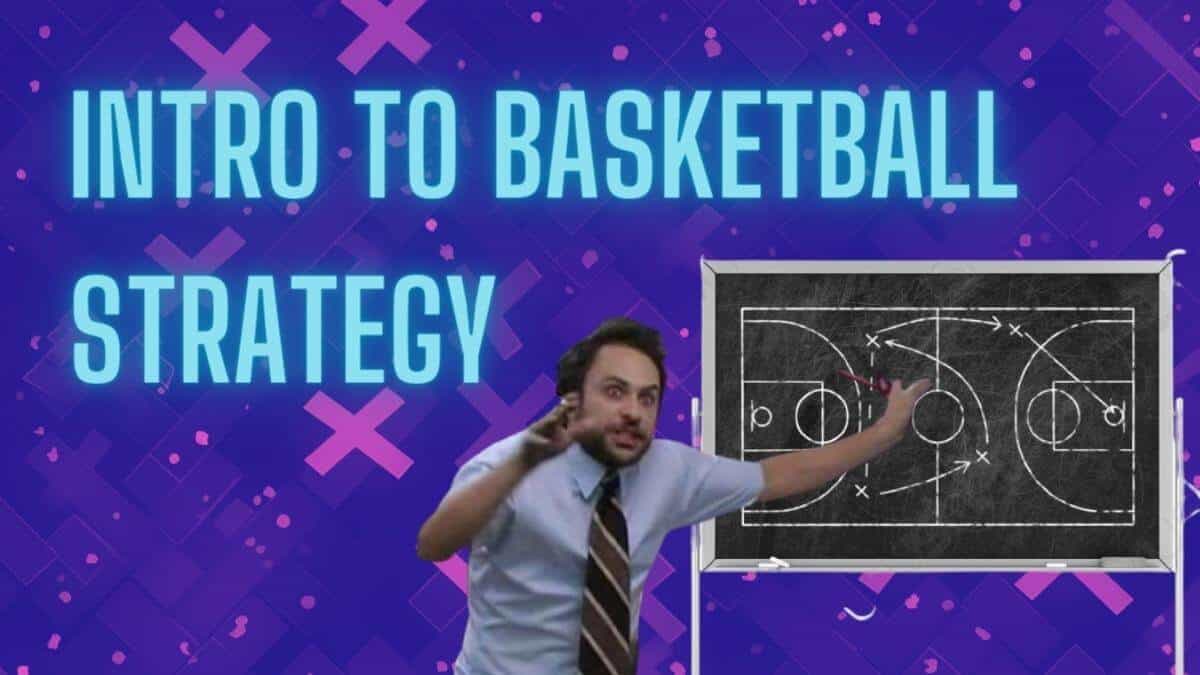So you’re interested in understanding hoops a little better, eh? Looking to slip into the warm and lathery jacuzzi that is basketball strategy? You’ve come down with a case of whatever it is that makes you want to take a perfectly good sport and ruin it with hyper-over-analysis?
Yeah baby, you have absolutely come to the right place. And this post is an absolute hack, built just for you…
By the end of this page, you’re gonna have the high-level understanding of basketball strategy that took me months of research and practice to develop on my own. I’m handing you the head start I wish I could have gotten.
Look, hoops strategy is an overwhelming mire of history, logic, biology, and physics, only further complicated by the intricacies of human psychology. I can’t hand you the assembled puzzle, but I can give you the big pieces and show you how they start to fit together.
So let’s get into it. We’re going to start off with one of the most valuable little tricks I’ve picked up in my years of studying basketball strategy. That way, if you don’t make it through this entire article right now, at least you’ll take something away from it.
How to watch basketball
Maybe you’re confident that you already know how to watch basketball. Skip ahead if you like. Otherwise, here’s a prescription-grade, high-leverage, basketball knowledge suppository for ya…
Stop watching the ball.
That’s it. One crucial concept. The devil is in the details. If you’re focused on the ball, you miss too many details. that’s not to say you should never watch individual players, or the ball, but at least learn how not to.
Strategy happens all over the court. To learn to recognize the patterns of basketball strategy, you need to learn to process the entire court.
This will take practice. You will have to remind yourself every so often to stop watching the ball. Over time it becomes quite natural.
I’ve found it helpful to focus on one side first, probably the offense. Follow the offense as they close in around the perimeter and begin probing the defense. Notice the spacing. See if you can predict ball movement.
You can learn a lot about basketball strategy by just watching player movement and searching for patterns. Don’t rush it. It can take hours upon hours of staring at basketball tape to begin to process the subtler movements.
Great! Now, let’s cover some of the patterns you’ll want to look out for as you watch.
Learning the game of basketball
Most of what you’ll find in this section can be picked up from just watching games. However, it can save you a lot of headache to have it all laid out from the start.
We’ll cover the traditional positions, the regions of the court, and a few of the more common basketball actions. This is just a lot of the basic language you encounter in your typical basketball broadcast. If you already understand most of what the announcers are saying during a typical game, you can probably skip ahead.
The Positions
Competitive basketball is most often played in a 5-on-5 format. The positions on each team are commonly labeled and numbered 1-5. The definitions are becoming increasingly blurred, but the rough guidelines still stand.The higher the number, the taller the player, and the closer they play to the basket.
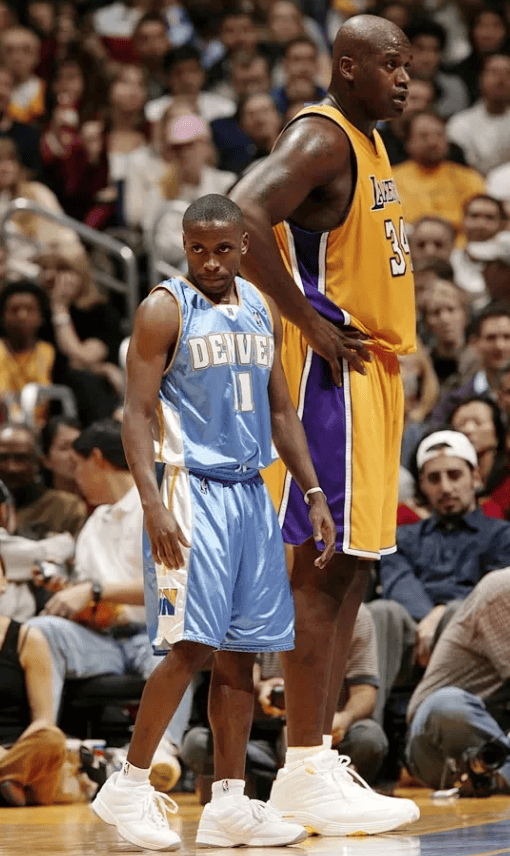
Smaller players tend to be quicker and more reliant on precision passing and shooting. Larger players are able to claim their space against opposition and knock down close range shots. Shaq played the 5 at 7′. Early Boykins was 5’5″ and played the 1.
It’s really common for players to flex over multiple positions over the course of a season, or sometimes even a game. But it’s more common to cover positions that are more closely related. A 5 may play the 4. A 4 may play the 3. It’s very uncommon for the 5 to play a 1 or 2. And it’s relatively uncommon for a player to regularly play at more than 2 different positions.
1. Point Guard
Something like the quarterback of the court. The PG sees and understands the flow of the game and adjusts accordingly. They are typically quick, with excellent court vision, passing skills, and ball handling.
The 1 is the point guard, the CP3 (that means Chris Paul, who is short and good at basketball and plays point guard) barking out orders. It’s kinda like a quarterback. Except these days we’re seeing more and more players who can run the floor from the post. But unless you’re playing with Nikola Jokić we can stick to the old school concepts.
Notable point guards: Chris Paul, John Stockton, Steve Nash
2. Shooting Guard
Often the team’s best shooter and a strong ball handler. The shooting guard should be a threat from the perimeter, as well as on the dribble. They need to spread the floor.
The shooting guard and the small forward are often referred to as the wings because they operate off to the sides of the court (also often referred to as the wings).
Notable shooting guards: Michael Jordan, Kobe Bryant, Reggie Miller
3. Small Forward
The small forward needs to match up against both smaller and larger players and play all over the court.
Notable small forwards: Scottie Pippen, Kawhi Leonard, Larry Bird
4. Power Forward
The power forward needs to be able to clear some space in the paint or set a powerful screen. They need to be able to throw their weight around and share some duties with the center. But they should also be a shooting threat. Mid range marksmanship and just pure athleticism are highly valuable here. Most power forwards will regularly flex into the center or small forward positions.
Notable power forwards: Draymond Green, Dennis Rodman, Dirk Nowitski
5. Center (a.k.a. The Big, a.k.a the Post)
Often the tallest and most massive player on the court. The center will play closest to the basket, sometimes just camping out at the edge of the paint and waiting for the ball. They are there to clear space for teammates to drive or get fed the ball so they can stuff it in the basket.
Notable centers: Kareem, Jokić, Shaq, Wilt
The Regions of the Basketball Court
The lane, the wings, the baseline oh my. Don’t forget the slots. There are a labels for all of the many regions of the court. Those labels are often used to describe where players stand or move, so its crucial to be clear on your court geometry.
The Sidelines and Baselines
A basketball court runs 95 feet by 50 ft. The longer sides are called the sidelines. The shorter sides are the baselines, or sometimes in rarer cases, the endlines.
Mid Court
No man’s land. The mid court line divides the 2 sides of the court. Once you cross this line, there’s no going back. Not without a penalty at least.
The Paint
The lines running from the free throw line to the baseline are called the lane lines and they enclose a region known as the paint. Most leagues will have rules about how long you can camp out in this region of the court. And when shooting free throws, you’re not supposed to enter this zone until the ball leaves the shooters hand.
Which brings us to…
The Blocks
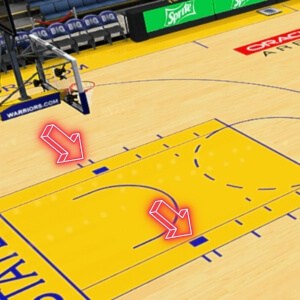
On a court with full markings, like the GSW court pictured here, there are a couple of little rectangles on either side of the basket.
These are the ‘blocks’ or the ‘low blocks’. The blocks mark important strategic locations on the court. This is about as close as you can get to the basket without camping in the paint. If you can get the ball in this spot, you have a strong shot at scoring.
The Elbows
Where the lane lines meet the free throw line at the corners of the pain that are further from the basket, you find the elbows. These are fantastic spots for mid range shot attempts or setting screens.
The Free Throw Line Extended
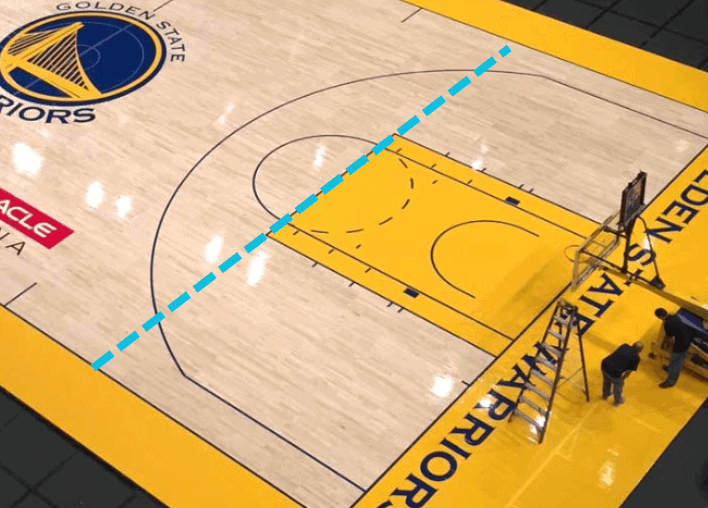
If you’ve made it this far, you don’t need me to explain the free throw line. However, if you extend the free throw line to the sidelines on both sides, you have an important reference line.
The phrase, ‘free throw line extended’ is often used to describe player positioning, and it designates the position of our next region…
The Wings
Where the free throw line extended meets the 3-point line, you find the two regions known as the wings. This term can sometimes refer to just the small region of the court surrounding that point, or it can sometimes refer to the entire strip of the court that runs along the sideline on either side of that point.
The Corners
Where the 3-point line meets the baseline on either side of the basket, you have the corners. The corners are special on pro courts (FIBA, NBA, WNBA) because they are the points on a court where the 3-point territory comes closest to the hoop.
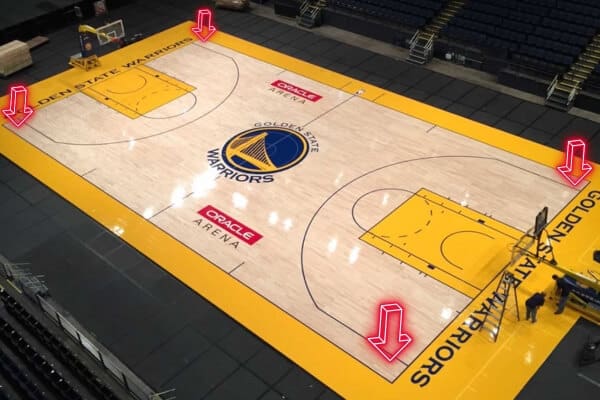
On an NBA court, the 3-point line is 23.75 feet from the basket. However, at the sides, the 3-point arc is clipped at 22 feet from the basket. So if you get the ball in the corner, you’re setup for a straight, 22 foot 3-point shot. There are players who have made their careers on this little piece of basketball strategy.
Weak Side and Strong Side
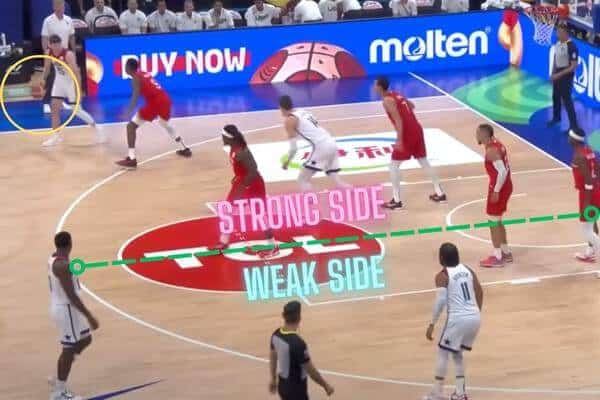
The terms ‘weak side’ and ‘strong side’ are often used to describe position on the court in relation to the ball.
If the ball is on one side of the court, that is the strong side of the court.
In the image here, Austin Reaves, pictured at top left, is in possession of the ball on the ‘strong side’ of the court. Jalen Brunson, pictured at bottom right, is on the opposite side of the court, the ‘weak side’.
If Reaves were to pass to Brunson, performing a ‘ball reversal’, the labels would be immediately switched.
The Restricted Area
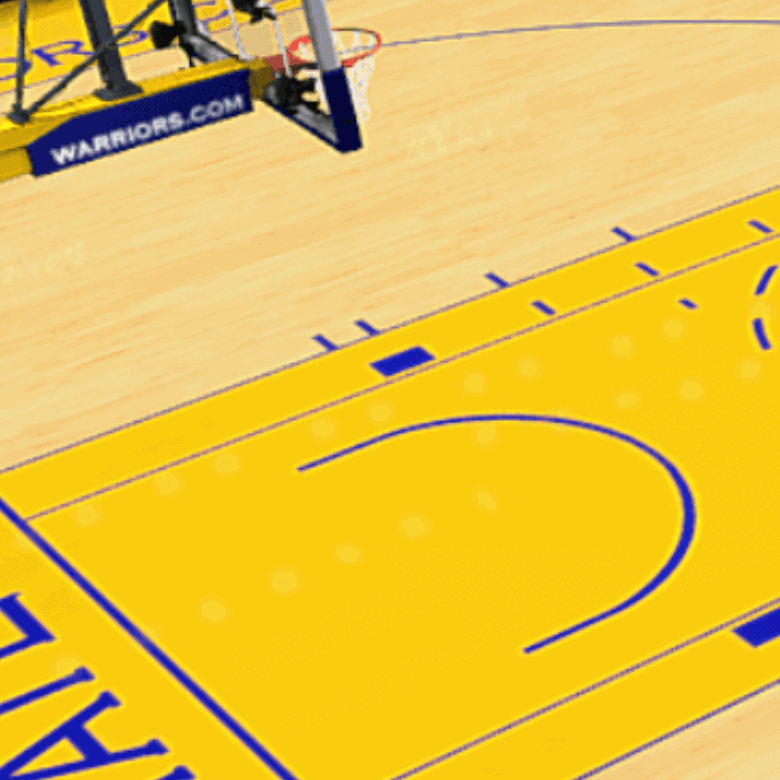
You know that little half circle under the basket? That defines the restricted area. A defender in the restricted area is not allowed to take a ‘charge’. That is, even if they are in a legal defensive stance, they can’t just stand there in this zone as offensive players drive to the basket.
Alright, so we’ve got the basic positions and court geography down. We can finally start talking about some of the moves.
Basic basketball actions
There are some simple techniques in basketball strategy that you’re going to see time and time again, so let’s just make sure we’re on the same page with those. This is still pretty basic knowledge, so feel free to jump to the next section if you’ve been watching hoops for awhile now and you understand cutting and screening.
Cuts
Cutting is when a player without the ball drives towards the basket. The goal here is to give the ball handler a passing target.
A player runs through traffic, shaking up the defense, and hoping to get themselves open for a pass.
There are a ton of different types of cuts, all labeled for their various qualities.
Screens
Screening is when a player sets themselves as a barrier against a teammate’s defender. A screen (a.k.a a ‘pick’) can be performed, ‘on-ball’, where the screen is placed for the ball handler, or it can be performed, ‘off-ball’, where the screen is placed for a player without the ball.
The goal of a screen is to interrupt defense and help your teammate get some room to make a play. With an on-ball screen, you’re trying to give your player some space to make a pass, take a shot, or drive to the basket. With an off-ball screen, you’re helping a teammate get open for a pass.
When a screen is performed correctly, the defender is faced with some tough choices. They can go ‘over’ the screen, racing around the outside to try and catch their matchup. They can go ‘under’ the screen, looking to head them off on the drive. Or, the defender can work with the screeners defender to ‘switch’ onto the screener to let the screeners defender cover their matchup.
The Roll and the Pop
Combining cutting and screening, you get two of the most common plays in basketball, the pick-and-roll and the pick-and-pop.
Both start with a screen. After the screen, the screener performs a cut. For a pick-and-roll, the screener comes off of their screen and ‘rolls’ towards the basket. For a pick-and-pop, the screener ‘pops’ out to the perimeter.
So the pick-and-roll sets the screener up to take an assist for a layup, or at least offer support on the ball handlers drive into the paint. The pick-and-pop sets the screener up to accept a catch-and-shoot, which is when they receive a pass and quickly put it up for a shot attempt.
Trapping
Trapping is an important defensive action. It is one of the most effective ways to force turnovers. As the ball handler approaches, the defender pressures them into a vulnerable position, usually against a sideline or a corner. A second, nearby defender, jumps in at the right moment to help.
When used correctly, the result is that the ball handler is trapped between 2 defenders and a sideline. To get out, they need to either thread a pass through two defenders or back pedal out of the trap.
Woof! That’s a lot of info, and we’re not even going very deep. Let’s just take a nice pause and appreciate how far we’ve come…
And… Let’s move on…
Key concepts in basketball strategy
Now that we’ve got the parameters of the game outlined, we can look at some court logic. These are the types of high-level goals that motivate much of what you see in a basketball game. The actions we went over in the previous section are often used in ways that promote the goals included in this section.
Shooters shoot
Generate shots for your best shooters. Most teams will have players who score more efficiently than others. It follows that a core strategy should focus on getting those players the shots they can knock down. It’s great to have players on your team that are good at things other than scoring. Just make sure that your scorers are getting the most scoring opportunities.
In a similar vein, your weaknesses should inform strategy as well. If you’re weak on shooting, focus on the paint. If you can’t knock down free throws, don’t commit fouls, etc.
Floor Spacing
The term gets thrown around a whole lot. Space the floor! But what does it acually mean?
Spacing the floor is when you present threats across the court, so that defenders are forced to cover a larger area. If your team is condensed in one region of the court, your opponent doesn’t have to try very hard or waste much energy to maintain coverage.
Hunt mismatches
Skill and size advantages are going to be a factor. Hunting out these advantages is a huge part of the game. If you’ve got a guard who can’t be stopped, or a post who can just push through to wherever they want to be on the court, you’re going to want to use screens and ball movement to try and get those players in a situation where they’re matched up against a lesser opponent.
Use the sidelines
The sidelines are like elite defenders that never get tired. You better watch out for them, and you cannot get through them. Getting your opponent up against the sideline is as good as a double-team. Getting them in a corner is even better.
Spontaneity
Basketball is a deeply improvisational sport. You can write the prescription in terms of dictating plays, but success is largely dependent on those split-second decisions that happen in the moment.
So you have to allow for spontaneity. In recent years, the coaching philosophies that allow for spontaneity on the court have become increasingly prevalent. Systems like flow or motion offenses are designed around generating possibilities for players, as opposed to prescribing specific plays. And they excel.
Basketball Coaching Philosophies
We’ve really come about as far here as we can get without watching a fair amount of basketball. So go watch some basketball.
But if you’ve got a good number of full games under your belt, games where you’re really paying attention, not games that are just on in the background, we can start looking at coaching philosophies and the state of modern basketball theory.
Modern basketball strategy
Turn on a game. Whatever league you watch, you’re probably going to notice an offense that congregates around that 3-point line. I think this is a crucial bit of understanding if you’re learning to watch modern basketball.
See, back in the day, basketball was played in the paint. The 3-point line didn’t even exist in the NBA until 1979. After that, it really took 20 years of evolution in skill and strategy for the arc to become the dominant strategic factor it is today. And it’s only in the past decade that the 3-pointer has evolved into the favored shot.
Kirk Goldsberry sums it up perfectly with this viral image he posted back in 2020.

Pretty wild, huh? It makes it pretty obvious that the entire NBA has trended away from mid-range shooting. And it’s difficult to underestimate the importance of this core shift in hoops strategy.
Understanding why and how this shift occurred ends up being a fascinating story, a story that can have a massive effect on how you watch basketball.
Motion Offense
I have a bunch of more detailed articles covering motion offense in its various styles. Start here if you want to get deep into the history and evolution.
The motion offense philosophy is hugely influential today, and it really ties together the 100+ years of evolution in basketball philosophy. So it’s a pretty good place to start a serious study of basketball. But for now, we just need some basics.
The concept behind the motion offense is that your team cycles through a series of movements designed to create scoring opportunities.
Pretty simple, right?
In practice, these movements subscribe to a set of guidelines.
One of these guidelines specifies even spacing at the perimeter. Generally, either 4 or all five of your players seek to maintain even spacing around the perimeter.
It tends to look something like this…
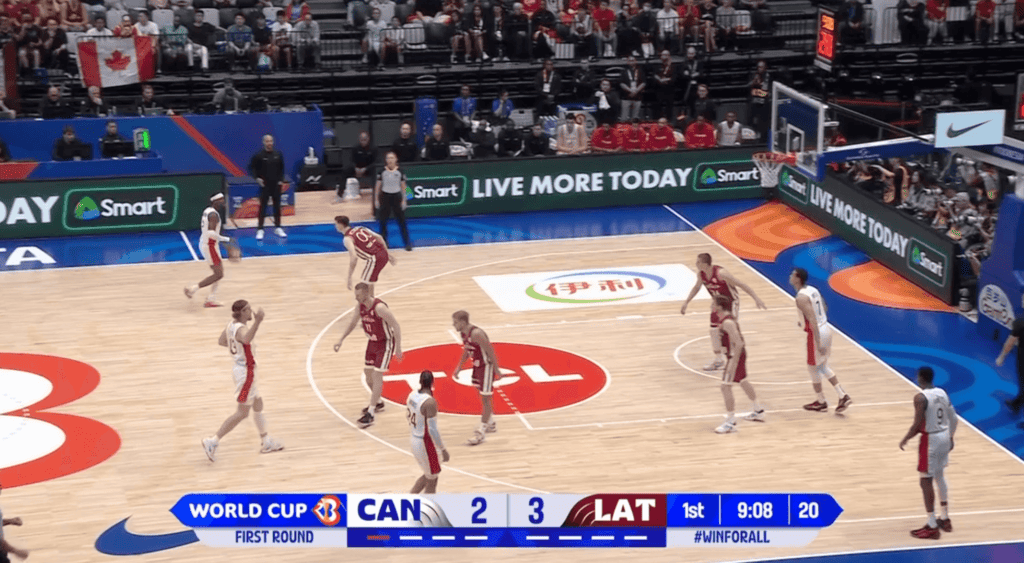
See the 4 guys in white, spread around the perimeter? See that one more dude, camping out at the edge of the paint, opposite the ball handler? That’s a very common motion formation.
It’s not perfect. It never will be. But you can see here that there are 4 guys hanging out outside the arc. And you can see that they are somewhat evenly spaced.
Another guideline suggests that, when a player is sent into the paint, they should hang out at the low block, at the edge of the key, just in front of the basket.
That would be where Dwight Powell (#7) is standing, guarded by two Latvians (the guys in maroon).
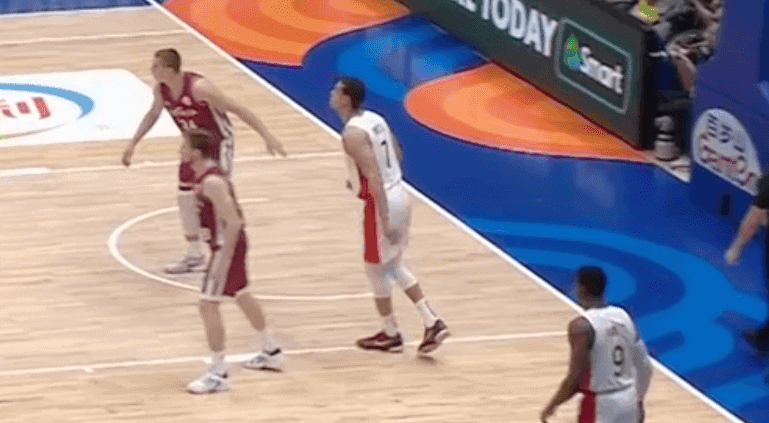
A third guideline suggests that the ball should enter on the side opposite that post player. Canada’s SGA (Shai Gilgeous-Alexander) is dribbling in from the left side.
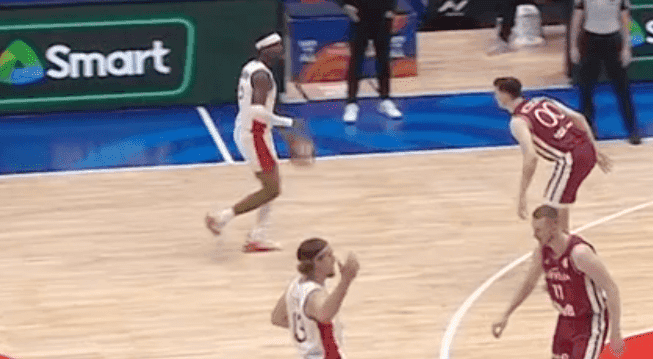
Again, by no means is this a perfect example of motion offense basketball. This is just a screen grab that took me 4 minutes to find off a recent World Cup game. Chances are, you can find a similar setup pretty easily.
Point is, it’s incredibly easy to find an offense that is evenly spaced around the perimeter. And it’s safe to say, when you see this formation, there is a strategy being employed that bares some relation to a subset of motion offensive principles.
Keep an eye out. See how often an offense approaching the goal will spread out evenly at the perimeter.
Maybe this is not that exciting for you. But it’s tangible progress on the road to unlocking the game behind the game, a small but sure step towards disconnecting from the basketball matrix to reveal the greater nature of hoops reality.
And the journey continues…
Other Basketball Coaching Philosophies
The motion offense is just one strategic philosophy in basketball, one theory of evolving basketball plays into a wider basketball strategic framework.
See, every once in awhile, a coach unravels some fundamental new understanding of basketball and develops a new theory of play. And when you’re a really cool and famous coach and your theory is effective, you can translate this theory into a philosophy that describes and informs your play design.
And you get to give it a name.
There are quite a few of these ‘coaching philosophies’ at this point. They serve well as organizational systems, like an outline through which you can approach basketball strategy as a whole. Some plays will always resist classification. Others will work well in multiple systems.
Either way, a quick review of some of the more popular systems can be very helpful in the early days of studying basketball strategy. I’ve got deep dives on each of these, just click the title for the link.
Keep in mind that you’ll hear people saying it will take years to implement some of these systems on even very advanced teams. I buy it. This is advanced stuff.
Also, if you do start to dig into this stuff a little more, you’ll want to sort out play diagrams. But we won’t be using any diagrams in this article.
The Princeton Offense
Much more common in college. Princeton still claims to run some evolution of the classic Princeton offense and they’re not alone, it’s still a popular schema.
The Princeton Offense is all about the back door cuts. A lot of the action happens at the elbows. You’re constantly screening to open up those diagonal cuts into the paint.
The Triangle Offense
One of the main guys who codified the triangle offense wasn’t convinced himself that it would function at the NBA level. It did function, and it helped power 2 of the greatest dynasties in NBA history, carrying the Bulls and the Lakers to a total of 11 titles under Phil Jackson.
In a triangle, you work to maintain an evenly spaced triangle on one side of the court. As the ball swings and players shift around, you recalibrate your triangle. Simple idea. Incredibly intricate system.
When you have a basic knowledge of the triangle, it really is amazing to see just how many elements from the triangle exist in other systems. Even as many hoops aficianados insist that the triangle is extinct in pro hoops, it’s fingerprints are everywhere.
Horns Offense
If you take a 5-out offense and drop your wings to the elbows, you’ve got this giant V on the half-court. And by playing those guys on the elbows, you open up some great screening opportunities into the slots.
I don’t see a lot of this offense in the pros these days, but it’s still quite popular in college and international hoops. Coach K was big on the horns offense.
Flex Offense
This can be an effective system for High School teams. It’s really just a specific motion set. It’s a 4-out with a particular play that it leans on.
There are plenty of other philosophies out there. A lot of them will be closely related to those above.
Defensive Strategy in Basketball
Having first approached the study of basketball strategy from the defensive end myself, I recommend starting with offense. I could be wrong, but I’ve found it helpful to come back and study defense with a clear understanding of what I’m defending against.
And that’s why I’ve nestled this section down here, under the offense. But that does not mean that defense is not important. And it’s important to note that, given the right mindset, good defense can be just as interesting and entertaining to practice as good offense.
Rebounding
There’s been some discussion of the value of the boards this year. By many assessments, Team USA botched the 2023 FIBA World Cup on their rebound game. That’s debatable, but still, getting on those boards is crucial.
A rebound, whether offensive or defensive, is an added possession. Take two teams with the same scoring efficiency, the team that wins on the glass will win the game. An offensive rebound is a second possession with prime court positioning.
Now there is the matter of how to rebound properly. And in that regard, there are two concepts that I want to mention.
The first concept is the study of ball movement. It is possible to predict the path of a ball based on its trajectory. Dennis Rodman claims he used to study shooters, noting rotation and angle, in order to better predict the ideal position for rebounding. And it sure seems to have worked.
Even without an exhaustive study of individual shots, there’s a rule of thumb here that can be incredibly advantageous. A basketball always has a higher probability of bouncing to the weak side. If a shot goes up, get yourself to the other side of the court.
The other key concept in rebounding is called ‘boxing out‘. This is the skill of positioning yourself for the advantage on the rebound. Proper boxing out involves identifying the ideal location for a rebound and setting yourself strongly, using your arms and butt to take up room and limit the mobility of surrounding players.
Zone Defensive Strategy
Any effective defense is going to be built on solid rebounding and defensive fundamentals. And you certainly need to consider matchups, pairing defenders with opponents of similar skills.
But strategic formations play a role in the strategy of basketball defense, just as they do with that of basketball offense. And these strategic formations in defense are known as ‘zone’ coverages.
The idea is that a defender is assigned to a specific region of the court. In training for and implementing a zone defense, a team works to synchronize movements within the zone in response to ball positioning. These movements are often referred to as ‘rotations’.
Zone is more common in the half-court. Perhaps the most widely recognized use of zone defense in basketball would be with Spoelstra’s Miami Heat. The heat have been known to run a very effective 2-3 zone.
Formations in a zone defense are often referenced by a set of 2-4 numbers. The numbers indicate how many players are positioned at each stage of the defense. For example, the 2-3 zone places a line of two players out front and a line of three more under the basket.
A List of Half-Court Zones
- The 2-3 Zone Defense
- The 3-2 Zone Defense
- The 1-2-2 Zone Defense
- The 1-3-1 Zone Defense
- The 2-1-2 Zone Defense
Pressing Zone Defenses
Press defense is a cool concept. Surface level, this is just an aggressive defense. As a team, you’re going to amp up your defensive intensity and ‘press’ the offense to make mistakes.
But trapping is a key feature of most press defenses. You’re sending your defenders to pressure their matchups into specific regions of the court, where help defense jumps in and forces heavily-contested moves.
These techniques will usually get rolled out in pressure situations. These strategies can force turnovers at a higher rate. But they can also leave exploitable gaps on the court.
Pressing defenses can be deployed across the whole court, or the half court. The full court press is the more aggressive tactic, but a full court formation can often be collapsed neatly into a half court system.
A List of Pressing Defenses
- Half Court Presses
- Full Court Presses
There’s one more strategy that I want to mention before we hang this all up. In some cases, you need to combine the reliability and organization of a zone with some man-to-man flexibility.
For that, you have hybrid systems. The most common hybrid defense would probably be the box-and-1. With this system, you setup a 4-man zone while your 5th player is free to hunt their matchup.
This specific defense had a bit of a moment in 2019 when the Toronto Raptors faced the Golden State Warriors in the NBA Finals. With Klay and KD injured, Nick Nurse’s Raptors made heavy use of the box-and-1.
Toronto’s Fred VanVleet was matched up on Steph Curry, while the rest of the Raptors fell into a boxed zone. The tape is remarkable. Steph is just running all over the court trying to find space, but getting worked over by a solid defender. It thoroughly disrupted the Warriors offensive system and gave the Raptors their one and only title.
Takeaways
Basketball strategy is very much a topic that could easily warrant an entire lifetime of study. But the hope here is that I’ve left you with the tools to begin your dive down the wormhole.
I know that not all of this stuff is perfectly structured. I have a long way to go in my own study of basketball strategy. But, having just spent the past few years trying to put all of this stuff together through books and blog posts and Youtube videos, I know this is the cheat sheet I wish I could have had when I fist got started.
And I’ll be back here in the future, to update and review all of this stuff as my own knowledge grows and congeals.
